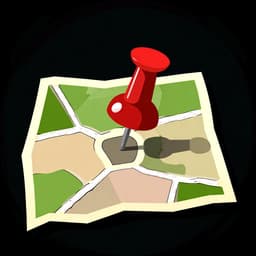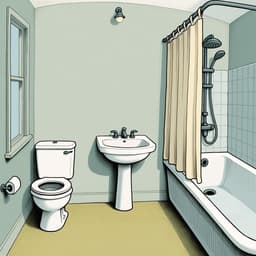Where is the bathroom?
in Spanish¿Dónde está el baño?
/DOHN-deh ehs-TAH el BAH-nyoh/
This is the most common, universally understood way to ask for the bathroom. It's polite, direct, and works in any situation, from a friend's house to a five-star restaurant.

A simple 'Disculpe...' (Excuse me...) is the perfect way to politely get someone's attention before asking, '¿dónde está el baño?'.
💬Other Ways to Say It
¿Disculpe, dónde está el baño?
/dees-KOOL-peh, DOHN-deh ehs-TAH el BAH-nyoh/
Adding 'Disculpe' (Excuse me) makes the question more polite. It's the perfect way to get someone's attention respectfully, especially a stranger or someone in a service role.
¿Perdón, dónde está el baño?
/pehr-DOHN, DOHN-deh ehs-TAH el BAH-nyoh/
'Perdón' (Pardon me/Sorry) is slightly less formal than 'Disculpe' but serves the same purpose of politely getting someone's attention. It's extremely common and versatile.
¿Dónde están los servicios?
/DOHN-deh ehs-TAHN los sehr-BEE-see-ohs/
This is a very common way to ask for the restroom in Spain, particularly in public places like bars, restaurants, and train stations. 'Servicios' is similar to the English 'services' or 'facilities'.
¿Dónde está el aseo?
/DOHN-deh ehs-TAH el ah-SEH-oh/
Another very popular term in Spain, often used interchangeably with 'servicios'. 'Aseo' often refers to a smaller bathroom, maybe without a shower, but it's widely used for public restrooms.
¿Los baños, por favor?
/los BAH-nyohs, por fah-BOR/
A slightly abbreviated but very polite way of asking. You're simply stating what you're looking for and adding 'please'. It's friendly and efficient.
¿Dónde está el W.C.?
/DOHN-deh ehs-TAH el DOH-bleh beh SEH/
Pronounced by saying the letters 'W' ('doble ve' or 'uve doble') and 'C' ('ce'), this is borrowed from the English 'Water Closet'. It's very common on signs and understood almost everywhere.
¿Dónde está el retrete?
/DOHN-deh ehs-TAH el reh-TREH-teh/
This word specifically means 'toilet'. While 'baño' refers to the whole room, 'retrete' is just the fixture. It can sound a bit blunt or less refined, but it's not a rude word.
🔑Key Words
Key Words to learn:
📊Quick Comparison
Choosing the right word for 'bathroom' often depends on where you are. Here's a quick comparison of the most common options.
| Phrase | Formality | Best For | Avoid When |
|---|---|---|---|
| ¿Dónde está el baño? | Neutral | Any situation, anywhere. It's the universal standard. | Never. It's always a safe and correct choice. |
| ¿Dónde están los servicios? | Neutral | Public places (restaurants, stations) in Spain. | In Latin America, where 'baño' is much more common. |
| ¿Dónde está el aseo? | Neutral | Another excellent choice for public restrooms in Spain. | Outside of Spain, as it's not a common term elsewhere. |
| ¿Dónde está el retrete? | Informal | Very casual contexts when you specifically mean the toilet. | Formal settings or when you want to sound more refined. |
📈Difficulty Level
Fairly easy for English speakers, with the only challenge being the 'ñ' sound, which is like the 'ny' in 'canyon'.
It's a fixed phrase. The main grammatical point is using 'está' (for location), not 'es', but you can just memorize the phrase as a single unit.
The nuance isn't about being offensive, but about knowing the preferred regional term ('baño', 'servicios', 'aseo') to sound more natural.
Key Challenges:
- Remembering the right regional word (baño, servicios, aseo)
- Pronouncing 'baño' with the 'ñ' sound
💡Examples in Action
Disculpe, señor, ¿dónde está el baño, por favor?
Excuse me, sir, where is the bathroom, please?
Oye, Ana, ¿puedo usar tu baño? ¿Dónde está?
Hey, Ana, can I use your bathroom? Where is it?
En España, es más común preguntar: 'Perdón, ¿dónde están los servicios?'
In Spain, it's more common to ask: 'Pardon me, where are the restrooms?'
El niño preguntó en voz alta: '¡Mami! ¿Dónde está el W.C.?'
The little boy asked out loud: 'Mommy! Where is the W.C.?'
🌍Cultural Context
The Many Names for One Room
One of the first things you'll notice is the huge regional variation in the word for 'bathroom'. While 'baño' is the universal safe bet, using 'servicios' or 'aseo' in Spain will make you sound more natural. This variety is a perfect example of how diverse the Spanish language is across different countries.
Public Restroom Etiquette
In many Spanish-speaking countries, it's not uncommon to have to pay a small fee to use a public restroom, especially in markets, bus stations, or tourist areas. There's often an attendant who provides toilet paper. In bars and cafes, restrooms are generally for paying customers only.
Reading the Signs
Bathroom doors are often marked with words instead of symbols. Look for 'Damas' (Ladies) or 'Señoras' for women, and 'Caballeros' (Gentlemen) or 'Señores' for men. You might also see 'Mujeres' (Women) and 'Hombres' (Men).
❌ Common Pitfalls
Using 'Ser' instead of 'Estar'
Mistake: "Asking '¿Dónde es el baño?'"
Correction: '¿Dónde está el baño?'
Forgetting to be Polite
Mistake: "Walking up to a stranger and just saying '¿Dónde está el baño?'"
Correction: Start with 'Disculpe...' or 'Perdón...'
Mispronouncing 'baño'
Mistake: "Pronouncing 'baño' like 'ban-no'."
Correction: Pronounce it as 'BAH-nyoh'.
💡Pro Tips
Always Start with a Politeness Marker
Make it a habit to begin your question with 'Disculpe' (formal excuse me) or 'Perdón' (pardon me). This small addition makes a big difference and shows respect, making people more willing to help you.
Prepare for the Answer
After you ask, be ready to hear basic direction words. Listen for key phrases like 'a la derecha' (to the right), 'a la izquierda' (to the left), 'al fondo' (at the back/end), or 'todo recto' (straight ahead).
When in Doubt, 'Baño' Works
Don't stress too much about remembering all the regional variations. If you're ever unsure which word to use, '¿Dónde está el baño?' will be understood by virtually every Spanish speaker on the planet. It's your foolproof option.
🗺️Regional Variations
Spain
While 'el baño' is perfectly understood, it's more commonly used for the bathroom in a private home. In public spaces like bars, restaurants, and airports, 'los servicios' or 'el aseo' are far more common and will make you sound like you know your way around.
Mexico
'El baño' is the undisputed king here. It's used everywhere, from homes to public places. You might hear older people say 'el excusado', but it's becoming less common. 'Sanitarios' is also used, especially on signage.
Argentina
Usage is straightforward and direct. 'El baño' is the standard term. Argentinians often use 'vos' instead of 'tú', so you might hear a friendlier, informal version like '¿Disculpá, sabés dónde está el baño?' (Excuse me, do you know where the bathroom is?).
💬What Comes Next?
After they tell you where the bathroom is.
Está al fondo, a la derecha.
It's at the back, to the right.
¡Muchas gracias!
Thank you very much!
If the bathroom is occupied.
Está ocupado ahora mismo.
It's occupied right now.
Ah, vale. Espero.
Oh, okay. I'll wait.
If you need to get a key first.
Necesita la llave. Está aquí en el mostrador.
You need the key. It's here at the counter.
De acuerdo, gracias.
Okay, thank you.
🧠Memory Tricks
This silly visual links the English sound 'banjo' to the Spanish word 'baño', making it easier to recall under pressure.
This technique, called code-switching, uses English-like sounds to create a memorable bridge to the correct Spanish phrase.
🔄How It Differs from English
The biggest difference from English is the variety of common, region-specific words for 'bathroom'. In English, 'bathroom', 'restroom', and 'washroom' are widely understood everywhere. In Spanish, 'baño' is universal, but 'aseo' and 'servicios' are very specific to Spain, and using them elsewhere can cause confusion. The concept is the same, but the vocabulary is more fragmented.
The level of directness is quite similar to English. It's perfectly normal to ask the question directly, but as in English, it's considered more polite to preface it with 'Excuse me' ('Disculpe' or 'Perdón').
🎯Your Learning Path
➡️ Learn Next:
How to say thank you
This is the essential polite response after someone helps you find the bathroom.
To the right / To the left
This helps you understand the directions you'll receive after asking your question.
How to say excuse me
Learning the different uses of 'perdón', 'disculpe', and 'con permiso' is a crucial next step for politeness.
How to ask for the check
This is another essential phrase for travel, often used in the same context (a restaurant) as asking for the bathroom.
✏️Test Your Knowledge
💡 Quick Quiz: Where is the bathroom?
Question 1 of 3
You're in a busy tapas bar in Madrid, Spain. What is the most natural way to ask the bartender for the restroom?
Frequently Asked Questions
What's the real difference between 'baño', 'aseo', and 'servicios'?
'Baño' is the universal word for a room with a toilet. 'Aseo' and 'servicios' are terms used almost exclusively in Spain for public restrooms. Technically, an 'aseo' might not have a shower, but in practice, they're used interchangeably for the facilities in a bar or restaurant.
Is it rude to just walk up and ask '¿El baño?'
It's not terribly rude, but it can be seen as a bit abrupt or demanding, especially with a stranger. It's much better to add a 'Disculpe' or 'Por favor' (please). A smile also goes a long way!
Why do some people say 'W.C.'?
'W.C.' stands for 'Water Closet,' which is an older English term for a toilet. This abbreviation was adopted in many parts of the world, including Spanish-speaking countries, especially for signage. You pronounce it by saying the Spanish letters: 'doble ve, ce'.
I asked where the bathroom is, but I can't understand the directions they give me. What should I do?
Don't panic! You can use gestures. Point and ask, '¿Allá?' (Over there?). You can also learn a few key words: 'derecha' (right), 'izquierda' (left), 'fondo' (back/end), and 'recto' (straight). Often, they will just point, so watch their hands!
What is the difference between 'Perdón' and 'Disculpe' before asking?
They are very similar. 'Disculpe' is a bit more formal and is perfect for getting the attention of a stranger you don't know. 'Perdón' is slightly more general and can mean both 'excuse me' and 'sorry'. For asking for the bathroom, you can't go wrong with either one.
Do I use 'está' or 'están'?
Use 'está' (is) if you're asking for 'el baño' (singular). Use 'están' (are) if you're asking for 'los servicios' (plural). For example, '¿Dónde está el baño?' but '¿Dónde están los servicios?'.
📚Continue Learning Spanish Phrases
Explore More Phrases in These Categories
Find similar phrases to expand your Spanish vocabulary:
Want to Learn More Spanish Phrases?
Browse our complete collection of Spanish phrases organized by situation, from basic greetings to advanced conversations. Perfect for travelers, students, and anyone learning Spanish.
View All Spanish Phrases →



